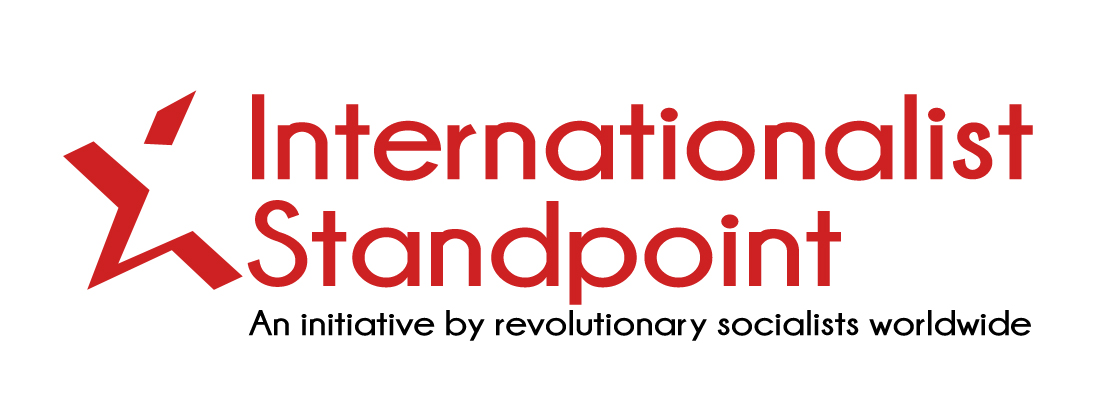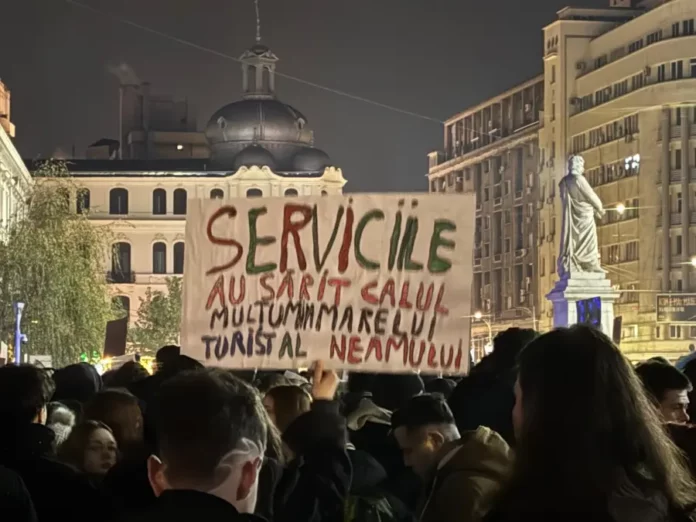Article by the ISp affiliate in Romania, GAS – Socialist Action Group
- For protest and mobilization against fascism. Against equating the far right with communism. Against equating communism with Ceaușescu’s regime and the degenerated USSR!
- Anti-fascism is anti-imperialist. Against pro-NATO and pro-EU slogans!
- Mass protests, not professional guild-based protests. The movement must not be led by NGOs!
- Anti-fascism means workers’ struggle against capital. Affirm this connection!
- Voting does not defeat fascism definitively but can only delay it. For the building of a mass workers’ party capable of becoming a tool in the fight against reaction and capital!
In recent days, we are witnessing mass mobilizations in the streets against presidential candidate Călin Georgescu. These demonstrations are primarily concentrated in major urban areas: Bucharest, Cluj, Timișoara, Brașov, Constanța, and Iași. We have already analyzed the reasons behind his rise in detail. It is necessary to provide clarifications about the nature of the protests, the social strata participating in them, and the class interests reflected in the messages and slogans.
A central theme of the protests is the defense of democratic rights, which are perceived to be at risk in the event of Georgescu’s victory. Furthermore, the memory of historical fascism remains vivid for many, and its dangers are widely recognized. The increased activity of fascist and neo-legionary groups surrounding Georgescu’s candidacy is rightly seen as an imminent threat to the safety and lives of many categories of people targeted by their violent attacks. This has lent the protests a mass character, rather than being niche or group-specific—a positive development. We are convinced that the need to actively defend the democratic rights enjoyed even under capitalism, as well as opposition to fascism and Bonapartist maneuvers, are becoming increasingly recognized by progressive segments of society.
Contradictions Within the Movement
However, alongside this, we note that opposition to legionary ideology and autarky is often articulated by organizers and some participants as support for transnational capitalist structures like the EU or NATO. The far right is countered by bourgeois democracy—undeniably a more stable state form than Georgescu’s proposed model but one that, through its inherent contradictions, periodically degenerates into fascism. Some slogans even attempt to equate the far right rallying behind Georgescu with socialism and communism, terms which some protesters associate with Ceaușescu’s stalinist-nationalist regime or the USSR after its degeneration from an initial workers’ state.
Revolutionary socialists must actively oppose such slogans, the conflation of the far right with the left, and the association of communism with Ceaușescu’s regime. At the same time, the anti-fascist struggle must be disentangled from support for structures like the EU and NATO—complicit in systemic oppression and violence against workers and popular layers both inside and outside Europe, as well as in the economic exploitation of the working masses in the center, the periphery and semi-periphery of the global capitalist system, where Romania also belongs. Georgescu’s vote base largely represents an explicit anti-EU and anti-NATO sentiment. Presenting these delegitimized structures as alternatives to the far right does nothing to advance the anti-fascist cause.
Socialists’ Role in the Anti-Fascist Struggle
Revolutionary socialists must also center their messaging on explaining how fascism is a violent dictatorship of capital, not an externality of the capitalist system. We need to articulate why a vote for the neoliberal alternative, such as USR’s Elena Lasconi, does not definitively defeat the far-right but only delays it in the short term. Therefore, voting is insufficient, and anti-fascists must engage primarily in the fight against capital, outside the electoral cycle. It is imperative to demonstrate why the anti-fascist struggle cannot be separated from the workers’ struggle against capital, highlighting how forms of organization against capital (e.g., militant unionization in workplaces, activism within unions) are also effective tools for combating fascism.
For revolutionary organizations, there are two dangers: sectarianism (which involves breaking away from the working masses and their movements) and opportunism (manifested in abandoning the working class as a revolutionary subject, inconsistency in approaches and proposals, or dissolving into broader structures and movements). We must avoid both. On the one hand, since the protests have taken on a mass character centered on anti-fascism and democratic rights, not engaging or speaking with participants would be a sectarian approach. On the other hand, simply joining as passive participants and adopting external slogans would mean the socialist movement follows rather than leads, failing to offer a progressive direction.
But to whom should our intervention be directed?
Class Dimensions of the Protests
As already mentioned, the anti-Georgescu protests are concentrated in major urban areas. Based on field observations, we can distinguish several social strata involved, each reflecting distinct class interests.
A significant number of young people, either workers or students, are alarmed by the rise of the far right. Some have been drawn in by bourgeois parties (such as USR, SENS, or REPER), while others do not necessarily sympathize with political organizations. Their support for the USR candidate stems from fear of fascism and the perception that the only alternative presented to them is to vote for the status quo. These individuals should be the primary targets of interventions, presenting them with a socialist perspective.
The presence of NGOs positioning themselves as the voice of “civil society” and mobilizing for protests is evident. Some are even among the organizers. These NGOs, which were formerly active (2017-2019) against PSD leader Liviu Dragnea’s government, maintain strong ties to Western capital, which stands to lose in the short term from a Georgescu victory. These organizations represent a segment of civil society whose activity is primarily about supporting so-called norms of good governance within capitalist democracy. In reality, their goal is to protect U.S. and transnational capitalist interests in Romania. Their methods include not only issuing proposals akin to think tanks but also attempts to demonstrate (at least performatively) that public sentiment supports these proposals.
The NGO sector primarily defends its own material and professional interests, as beneficiaries of funds or freelance workers reliant on these resources. Their real fears lie in greater scrutiny of funding sources or potential difficulties in securing such funds. For this reason, they are behind the frequent emergence of pro-EU and pro-NATO slogans, as well as calls to distance from anarchist, socialist, or anti-fascist (“antifa”) groups and symbols. This sector of civil society wants the protests to be explicitly pro-status quo and pro-bourgeois political forces, which is why their legitimacy as protest “coordinators” should be challenged by us whenever possible.
The protests have also drawn in petty-bourgeois elements whose interests align with European capitalists. Additionally, certain far-right “pro-unionist” (pro-Moldova annexation) groups have intervened in the protests with clear anti-communist messages. Interaction with these parts of the protester base is unproductive and should be avoided. Reducing their presence and influence is a priority, and when possible, this objective should be made explicit.



